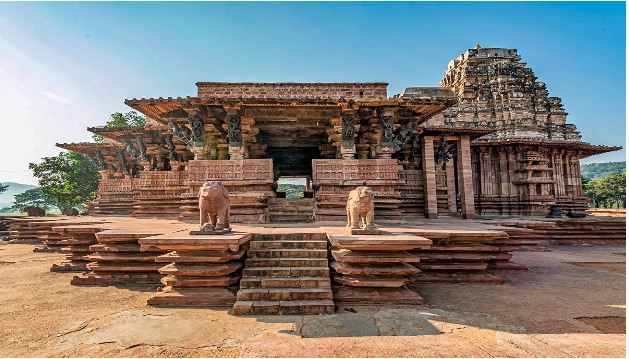Heritage camp at Ramappa temple
Context
A 12-day World Heritage Volunteers (WHV) Camp-2022 will be organised under the aegis of the Warangal-based Kakatiya Heritage Trust at the historic Ramappa temple in Palampet of Mulugu district.
About Ramappa Temple
- Ramappa Temple, also known as the Rudreshswara (Lord Siva) temple, is a UNESCO World Heritage Site located in the state of Telangana.
- It lies in a valley in Palampet village of Venkatapur Mandal of Mulugu district, a tiny village long past its days of glory in the 13th and 14th centuries.
- An inscription in the temple dates it to the year 1213 CE and says it was built by a Kakatiya General Recharla Rudra Deva, during the period of the Kakatiya ruler Ganapati Deva.
- This temple was constructed by Kakatiya king Ganapati Deva’s general Recharla Rudra.
- Kakatiya Dynasty was the South Indian dynasty that ruled Andhra Pradesh in India from 1083 CE to 1323 CE.
- Ramalingeswara Swamy is the presiding deity of this temple.
- Marco Polo, during his visit to the Kakatiya Empire, allegedly called the temple “the brightest star in the galaxy of temples”.
Architecture
- The temple complexes of Kakatiyas have a distinct style, technology, and decoration exhibiting the influence of the Kakatiyan sculptor.
- The temple stands on a 6 feet high star-shaped platform with walls, pillars, and ceilings adorned with intricate carvings that attest to the unique skill of the Kakatiyan sculptors.
- The foundation is built with the “sandbox technique”, the flooring is granite, and the pillars are basalt.
- The technique involved filling the pit — dug up for laying the foundation — with a mixture of sand-lime, jaggery (for binding) and karakkaya (black myrobalan fruit) before the buildings were constructed on these 'sandboxes'.
- The sandbox in the foundation acts as a cushion in case of earthquakes.
- Most of the vibrations caused by earthquakes lose their strength while passing through the sand by the time they reach the actual foundation of the building.
- The lower part of the temple is red sandstone while the white gopuram is built with light bricks that reportedly float on water.
- The Kakatiya temples, dedicated mostly to Siva, reveal in their construction a happy blending of the styles of North India and South India which influenced the political life of the Deccan.
- They adopted both the North Indian Nagara Bhumija style and the South Indian Dravida style.
- The most important of these temples are those at Palampet (Ramappa temple), Hanamkonda (Thousand Pillared temple) and the temples in the Warangal fort including the big ruined temple complex — Swayambhunadha temple.
Benefits of becoming a World Heritage Site
- The following are the most important advantages of being a World Heritage Site:
- It brings international attention to the need for the preservation and conservation of the site.
- It brings tourism to the site, with its accompanying economic benefits to the host country and local area.
- It can provide funds for restoration, preservation, and training.
- For example, in 2001, the Taliban destroyed two 6th century, 150-ft. statues of Buddha carved into the mountainside in the Bamiyan Valley in Afghanistan.
- It promotes national and local pride in the natural and man-made wonders of the country.
- It promotes close ties with the United Nations system and the prestige and support it provides.
- It provides access to global project management resources.
- It facilitates creating partnerships between government, the private sector, and NGOs to achieve conservation goals.
- The site is protected under the Geneva Convention against destruction or misuse during wartime.
UNESCO World Heritage Site
- A UNESCO World Heritage Site is a place that is listed by the United Nations Educational, Scientific and Cultural Organization (UNESCO) as of special cultural or physical significance.
- The list is maintained by the international World Heritage Programme administered by the UNESCO World Heritage Committee, composed of 21 UNESCO member states which are elected by the General Assembly.
- Each World Heritage Site remains part of the legal territory of the state wherein the site is located and UNESCO considers it in the interest of the international community to preserve each site.
- The List of recorded sites on the World Heritage include natural or man-made areas or a structure that is of international importance and requires special protection.
- Italy is home to the greatest number of World Heritage Sites with 50 sites.
- India now has 40 world heritage sites, including 32 cultural heritage sites, 7 natural sites and 1 mixed site.
- It makes India seventh ranked country in the list of world heritage properties.
|
About United Nations Educational, Scientific and Cultural Organization (UNESCO)
|


